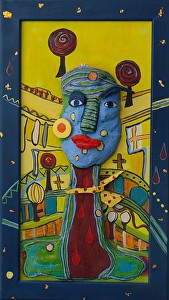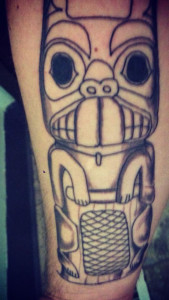
I Thought I Knew You: a contemporary totem by Marilynne Eichinger


Beaver Totem by Ray Losey Beaver Tattoo outline
Tattoo Taboo
Last year Ray made a totem pole for an Oregon sports club whose mascot was the beaver. One of their members was so impressed with the sculpture that he decided to have a tattoo of Ray’s design inked on the back of his calf. Above photos show the pole and the leg that will be colored over the next several months.
Though we felt honored by this gesture, tattoos represent quite a generational disconnect to me. As a child, my friends and I were fascinated by photographs in National Geographic displaying body art on Polynesian people. Those images were a curiosity that spoke of the exotic, but were labeled by my peers as belonging to a primitive culture, not to be duplicated. The process appeared to be agonizing and made us wonder why anyone would want to mar their body in that way.
Today, with new and less painful technology, many people wear tattoos. They are often quite artistically executed, but I continue to wonder why anyone would want such permanent body art. I prefer the option of being able to change my selections whenever I desire. I choose jewelry and scarfs to accompany my mood and clothing. Paintings on my walls are juxtaposed with nearby furniture in order to show the art off to its best advantage. Their attractiveness depends on placement, good lighting, and coordinated colors.
Body art needs be displayed with the same holistic approach as a painting, yet it is rare that clothing enhances the tattoo. I recently watched a bride walk across the far side of a hotel lobby wearing a beautiful white satin gown. Her bare arms were covered with blue/black tattoos. From a distance she looked dirty, and I wanted to wash away the smudges so she could glow. I wondered how she was going to enjoy her body in fifty years. Sagging, flappy old age skin will change the appearance of her carefully executed youthful designs. I questioned whether she will join the 60,000 people the American Society for Aesthetic Plastic Surgery say had tattoos removed in 2012.
Tattooing is an ancient art. There is evidence that it existed during the bronze age five thousand years. A frozen body known as otzi, the ice man discovered in the Alps was covered with fifty-seven tattoos. On every continent of the world there are examples of ancient people adorned with some form of body markings. In North American the Chickasaw decorated outstanding warriors, Iroquois tattoos were a recognition of rank, and Inuit women’s chins were decorated to indicate marital status.
Tattooing (known as tatau) in Polynesia began over 2000 years ago, and represents some of the finest work of its type. Rank and title were reflected by the tafutga (tattoo artist) who spent long hours perfecting designs. The pain of being tattooed was extreme carrying with it a high risk of infection. A person who aborted the process was considered incomplete and a coward.
It is Polynesian body art that has had the greatest effect on contemporary society. In the mid-1700s, explorers brought back reports about it from their travels. They described the elaborate body designs that made men look as though they were fully clothed. Their descriptive accounts fascinated the public, and the practice took hold on sailors and society’s fringes.
The practice declined, however, with the influx of Christian missionaries from the west. They vilified the custom as inhumane, barbaric and unholy. In most mission schools youth were forbidden to wear tattoos. Over time the missionaries did relax their attitude.
In the United States the first permanent tattoo shop was opened in 1846 in New York City. The practice grew with patriotic fervor as military men were drawn into body decorations during the World War II era. By the 1950s tattoos were more widely accepted, though they continued to be generally disdained by upper society. Today tattooing is considered an legitimate art form that appeals to both sexes. 21% of Americans have one or more tattoos according to a Harris Poll conducted in 2012. People get tattooed for social, political, and religious reasons. Some are applied as recognition of group affiliation, others are expressions of love, while many are forms of self-expression or fashion statements.
I find it interesting that 86% of tattooed people say they have never regretted getting it while those without tattoos hold strong opinions against the custom. One-quarter of those polled say that tattooed people are less intelligent, healthy or spiritual. 50% consider them to be rebellious, and two out of five think they are less attractive and less sexy.
People are more likely to get tattoos if their friends and family have them, and as the custom has grown it became better accepted by society. Even though I continue to stare with curiosity, I am no longer horrified. There are increasingly more people getting their tattoos removed. Though many are artistically executed there are a also great many mistakes . . . even by well paid professionals. Other reasons for removal are that the individual longer finds the design relevant, it is not perceived as appropriate for professionals, or it does not project the current image a person has of his or her self.
I would love to hear what you think of tattoos. Do respond on my blog.
Art work is always for sale. Go to eichingerfineart.com to learn more.
Want to know more ?
http://www.smithsonianmag.com/history/tattoos-144038580/?no-ist=&page=5 – history of tattoos
http://www.pbs.org/skinstories/history/ – history of tattoos
http://www.designboom.com/history/tattoo_history.html – history of tattoos
http://time.com/2826644/you-better-have-a-good-reason-for-that-tattoo/ – tattoos and regret
http://www.usatoday.com/story/news/nation/2014/05/21/tattoo-removal-laser-treatment/8892601/ – love/hate relationship with tattoos
http://www.vanishingtattoo.com/tattoo_facts.htm – tattoo facts.
Home » Blog » Tattoo Taboo
Table of Contents
I Thought I Knew You: a contemporary totem by Marilynne Eichinger
Beaver Totem by Ray Losey Beaver Tattoo outline
Tattoo Taboo
Last year Ray made a totem pole for an Oregon sports club whose mascot was the beaver. One of their members was so impressed with the sculpture that he decided to have a tattoo of Ray’s design inked on the back of his calf. Above photos show the pole and the leg that will be colored over the next several months.
Though we felt honored by this gesture, tattoos represent quite a generational disconnect to me. As a child, my friends and I were fascinated by photographs in National Geographic displaying body art on Polynesian people. Those images were a curiosity that spoke of the exotic, but were labeled by my peers as belonging to a primitive culture, not to be duplicated. The process appeared to be agonizing and made us wonder why anyone would want to mar their body in that way.
Today, with new and less painful technology, many people wear tattoos. They are often quite artistically executed, but I continue to wonder why anyone would want such permanent body art. I prefer the option of being able to change my selections whenever I desire. I choose jewelry and scarfs to accompany my mood and clothing. Paintings on my walls are juxtaposed with nearby furniture in order to show the art off to its best advantage. Their attractiveness depends on placement, good lighting, and coordinated colors.
Body art needs be displayed with the same holistic approach as a painting, yet it is rare that clothing enhances the tattoo. I recently watched a bride walk across the far side of a hotel lobby wearing a beautiful white satin gown. Her bare arms were covered with blue/black tattoos. From a distance she looked dirty, and I wanted to wash away the smudges so she could glow. I wondered how she was going to enjoy her body in fifty years. Sagging, flappy old age skin will change the appearance of her carefully executed youthful designs. I questioned whether she will join the 60,000 people the American Society for Aesthetic Plastic Surgery say had tattoos removed in 2012.
Tattooing is an ancient art. There is evidence that it existed during the bronze age five thousand years. A frozen body known as otzi, the ice man discovered in the Alps was covered with fifty-seven tattoos. On every continent of the world there are examples of ancient people adorned with some form of body markings. In North American the Chickasaw decorated outstanding warriors, Iroquois tattoos were a recognition of rank, and Inuit women’s chins were decorated to indicate marital status.
Tattooing (known as tatau) in Polynesia began over 2000 years ago, and represents some of the finest work of its type. Rank and title were reflected by the tafutga (tattoo artist) who spent long hours perfecting designs. The pain of being tattooed was extreme carrying with it a high risk of infection. A person who aborted the process was considered incomplete and a coward.
It is Polynesian body art that has had the greatest effect on contemporary society. In the mid-1700s, explorers brought back reports about it from their travels. They described the elaborate body designs that made men look as though they were fully clothed. Their descriptive accounts fascinated the public, and the practice took hold on sailors and society’s fringes.
The practice declined, however, with the influx of Christian missionaries from the west. They vilified the custom as inhumane, barbaric and unholy. In most mission schools youth were forbidden to wear tattoos. Over time the missionaries did relax their attitude.
In the United States the first permanent tattoo shop was opened in 1846 in New York City. The practice grew with patriotic fervor as military men were drawn into body decorations during the World War II era. By the 1950s tattoos were more widely accepted, though they continued to be generally disdained by upper society. Today tattooing is considered an legitimate art form that appeals to both sexes. 21% of Americans have one or more tattoos according to a Harris Poll conducted in 2012. People get tattooed for social, political, and religious reasons. Some are applied as recognition of group affiliation, others are expressions of love, while many are forms of self-expression or fashion statements.
I find it interesting that 86% of tattooed people say they have never regretted getting it while those without tattoos hold strong opinions against the custom. One-quarter of those polled say that tattooed people are less intelligent, healthy or spiritual. 50% consider them to be rebellious, and two out of five think they are less attractive and less sexy.
People are more likely to get tattoos if their friends and family have them, and as the custom has grown it became better accepted by society. Even though I continue to stare with curiosity, I am no longer horrified. There are increasingly more people getting their tattoos removed. Though many are artistically executed there are a also great many mistakes . . . even by well paid professionals. Other reasons for removal are that the individual longer finds the design relevant, it is not perceived as appropriate for professionals, or it does not project the current image a person has of his or her self.
I would love to hear what you think of tattoos. Do respond on my blog.
Art work is always for sale. Go to eichingerfineart.com to learn more.
Want to know more ?
http://www.smithsonianmag.com/history/tattoos-144038580/?no-ist=&page=5 – history of tattoos
http://www.pbs.org/skinstories/history/ – history of tattoos
http://www.designboom.com/history/tattoo_history.html – history of tattoos
http://time.com/2826644/you-better-have-a-good-reason-for-that-tattoo/ – tattoos and regret
http://www.usatoday.com/story/news/nation/2014/05/21/tattoo-removal-laser-treatment/8892601/ – love/hate relationship with tattoos
http://www.vanishingtattoo.com/tattoo_facts.htm – tattoo facts.
Table of Contents